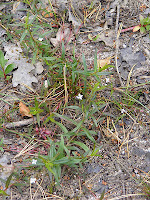- Leaves - shape, hairiness, stalked or not.
- Habit - creeping (rooting at nodes) or erect.
- Flowers - colour.
- Flower stalks - length.
- Stems - hairy all over or in 2 distinct rows.
- Fruits - shape, hairiness.
- Those with solitary flowers in the leaf axils.
- Those with flower heads at the ends of main stems.
- Those with flower heads in the leaf axils.
Below, 2 photos of Veronica sp, in our orchard, April.


Below, 1 photo of Common Field Speedwell V. persica, on the side of a track through a vineyard near Saint-Aignan, April. A spreading non-native (introduced from Asia) with roughly triangular leaves and single flowers that come on long stems from the leaf axils. Very common, especially in arable and waste land. Flowers all year.

Below, 2 photos of Thyme-leaved Speedwell V. serpyllifolia, on a ride (forest track) in the Parc de Boussay, April. This is a creeping plant with small smooth edged leaves and pale flowers in erect spikes at the ends of stems. Common in grasslands, heaths, open woodland and waste ground. Flowers from March to October.


Marsh Speedwell V. scutellata: called Véronique a écus in French (='coat of arms veronica'). Slender creeping stems, up to 30 cm tall with opposite spear shaped leaves. The flowers are white or pale blue with purple stripes, June to August. Grows in bogs, wet meadows and ponds, locally fairly common. Below, photographed in the drawdown zone in the Etang de Ribaloche in the Foret de Preuilly, June.








No comments:
Post a Comment